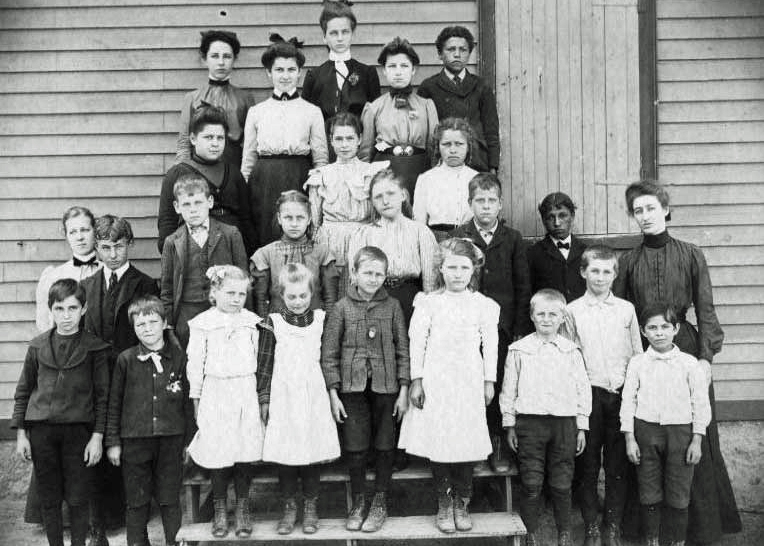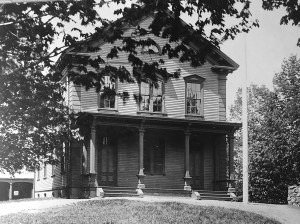True Tales from Canton’s Past: Coming to Canton
By George T. Comeau
Ms. Julia Crowley taught at the one-room schoolhouse on York Street and is shown with a class of young students circa 1900. (Courtesy of the Canton Historical Society)
This story originally appeared in the April 26, 2018 edition of the Canton Citizen and was republished this week.
There is a beautiful Irish song with lyrics that evoke a lovely scene. “How I longed for to roam, by Mount Massey’s green groves or poach by the light of the moon. That spot of my birth, there’s no place on earth, Like Mount Massey, the flower of Macroom.” The music alludes to the market town in County Cork and the small village of Mount Massey, where tenements developed alongside Macroom Castle.
Inside a small neat cottage, Cornelius Crowley watched his three brothers die in the grips of the Gorta Mór — the Great Famine. Born in 1840, Crowley was 5 years old when the famine began. The family was poor and the small cottages that made up Crowley’s village were of no protection against the weather. Beds and blankets were luxuries that few could afford and it is likely that the only property the family would own consisted of a pig and a manure heap.
Little is known of Crowley’s life in Ireland. There are specks of family history that show he fought as a private with the 1st Madras Fusiliers and received a medal for his service in India at Lucknow during the Indian Rebellion of 1857. At some point, like so many of the hundreds of thusands of Irish, he left his home and came to America sometime before 1870. We believe that Crowley came here with his brother Timothy and they settled in the 9th Ward of Boston.
An 1870 census lists Crowley as a laborer alongside several other men with the occupation of “hostler.” There were 13 people who lived in that home, and many could not read or write — Crowley among them. This was a house full of what we would call stablehands. In 1870 Boston there were 530 hostlers, and by 1880 that number would exceed 1,400. Most of these men were either black or Irish. The work was quite undesirable and paid extremely low wages. The men worked seven days a week and there was considerable idling time, which led to drinking, brawls, gambling, and excessive behavior.
It seems that Crowley kept to the right side of things. By 1874 Crowley was living in Canton, and that same year he married Mary Sullivan and she joined him on the Pierce Estate, which is now the Ponkapoag Golf Course. Crowley had somehow become employed by Henry L. Pierce, a well-known Republican politician. Amassing a large fortune, Pierce followed in his father’s footsteps and became a member of the Massachusetts House of Representatives. In 1870, after Dorchester became part of Boston, Pierce won election as the 22nd mayor of Boston and returned as mayor for a second term in 1877. In 1873, Pierce was elected to the 43rd Congress and served two terms. Redman Farm was Pierce’s playground opened to all his friends.
It would fall to Crowley to assist in managing over 200 acres of the property. Prize Jersey cows grazed splendidly as if waiting for a Flemish painter to add them to the quiet landscape. One cow alone cost over $6,000, and the entire herd was valued at $40,000. The cultivation of hay on this farm exceeded many of the farms in the area and the output was closely managed by a large staff on hand. Through the years that Crowley lived in the Redman Farmhouse he had six children. And, true to the immigrant dream, they could do what he could not — read and write.

There were nine graduates from Canton High School in 1892. (Courtesy of the Canton Historical Society)
Julia Crowley was born on the farm in 1877 and was the second daughter born to Mary and Cornelius. There is little doubt that the impact that Julia made on Canton was undeniable. As a child, Julia would walk to the Eliot School less than a mile away from the farm. Graduating from Canton High School in 1892, Julia Agnes Crowley, the child of immigrants, was awarded a diploma. Julia’s father and mother sat quietly and brimmed with pride as they saw their dreams realized. Only nine students graduated that year and Crowley was among the best. The program that evening at Memorial Hall included the reading of an essay entitled “A Group of Famous Men” written by the young graduate herself.
Soon after leaving Canton High School, Crowley attended the Bridgewater State Normal School to “learn the art of teaching.” It was an exciting time in Bridgewater. Women and men from across the state came to learn how to become teachers. During the time that Crowley was there, the school opened a new training school with seven classrooms, eight grades, and over 175 pupils. There were classrooms, laboratories, offices, an assembly hall for 250 students, a library and gymnasium as well as manual training shops and playrooms. Crowley lived in an impressive new dormitory along with 250 fellow students. The education included child psychology, history of education, teaching under criticism, and how to adjust the conditions of work under varying school economies. It was a thrilling time to become a teacher, best described as “a new epoch in teacher training.”
It was difficult to be accepted into the Normal School. A written examination was followed by an oral interview in order to gain “an idea of the candidate’s personality, physique, presence, health, temper, tact, patience and moral spirit.” Crowley spent four years training to become a teacher and graduated in 1898. Returning home to Canton, she began looking for a position in a local school system. It did not take long.
That same spring, two teachers resigned — Miss Ella L. Bright and Miss Georgie E. Downes. The resignations created two vacancies at the Ponkapoag School, and there was a shuffle from the small schoolhouse on York Street creating a vacancy. The superintendent was pleased to report that the position would be filled by “Miss Julia A. Crowley of Canton, a graduate of our high school and of the Bridgewater Normal School.” The job paid $180 per term and there were 29 students in a very small one-room schoolhouse. The building still stands on the curve at York Street and is in quite decrepit condition.
Julia Crowley went on to teach at York Street for nine years before transferring to the Revere School. The old Revere School at the corner of Neponset and Chapman streets was a two-room schoolhouse. The now seasoned teacher was on the first floor and taught grades I, II, and III. Crowley had 55 pupils and was paid $500 that year. Her teaching career lasted for more than 44 years. In a remarkable achievement, all estimation shows that she touched the lives of more than 2,500 children.
Crowley never married and spent her entire life in the service of the town of Canton. Never owning a home, she lived with nieces and nephews until her death in 1962 at age 85. Buried in the family plot at Saint Mary’s, there is likely no one alive still today that was influenced by her work. Yet it is in the immigrant story that we find the richest threads. There are, in fact, still Crowley descendants here in Canton. From generation to generation the lineage still creates a strong sense of the past. And that song about their home in Ireland captures a lovely verse: “For now I must roam, from my own native home, and cross o’er the wild raging sea, to leave friends behind both loving and kind.”
We are richer as a result of their roaming.
Special thanks to David Crowley for his kind assistance with this story.
Short URL: https://www.thecantoncitizen.com/?p=38729










